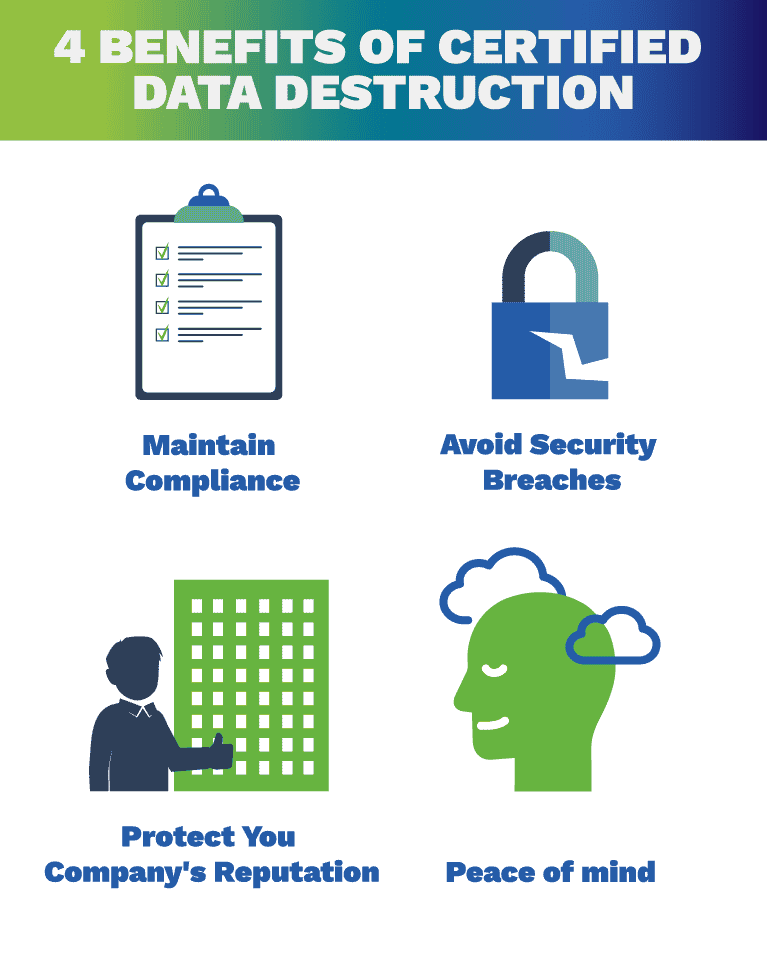Recognizing the Function of Data Destruction in Strengthening Cyber Security Defenses
Recognizing the Function of Data Destruction in Strengthening Cyber Security Defenses
Blog Article
Exploring the Significance of Data Destruction in the Context of Computer Security Providers and Protecting Confidential Information
In an era where data violations are progressively common, the value of effective data destruction can not be overemphasized. What techniques can companies execute to improve their information devastation protocols?
Understanding Data Damage
Data destruction is a crucial part of computer system protection that involves the irreversible elimination of data from storage devices to protect against unauthorized accessibility and prospective information violations. In a significantly electronic landscape, companies encounter increased threats related to sensitive details being poorly accessed or made use of. Efficient data devastation safeguards versus these threats, ensuring that private dataâEUR" such as consumer information, copyright, and monetary recordsâEUR" can not be recuperated after disposal.
Understanding the relevance of data destruction extends beyond simple compliance with legal and regulatory frameworks; it is necessary for preserving organizational honesty and count on. When information is poorly handled or improperly ruined, the effects can be serious, including financial loss, reputational damages, and lawful responsibilities.

Approaches of Data Eradication

One prevalent technique is data cleaning, which entails overwriting existing data with random patterns several times. This technique provides the original information irretrievable, making it a prominent option for companies seeking to safeguard secret information.
An additional technique is degaussing, which utilizes an effective magnetic area to interrupt the magnetic domain names on storage tools, efficiently erasing the information. This approach is especially efficient for magnetic media but is not suitable to solid-state drives.
Physical destruction is an additional durable technique, crushing or entailing the shredding of storage gadgets. This technique guarantees that data recovery is basically impossible, making it perfect for extremely sensitive info.
Last but not least, security can work as a corresponding approach to data elimination. By encrypting data prior to removal, companies can add an additional layer of safety, guaranteeing that also if remnants are recovered, they continue to be hard to reach without the decryption key. Each approach ought to be picked based on the level of information sensitivity and the particular safety and security requirements of the company.
Legal Conformity and Data Security
Organizations should navigate a complicated landscape of legal requirements associated with information safety, particularly after carrying out methods of information removal. Various regulations, such as the General Information Security Guideline (GDPR) and the Medical Insurance Mobility and Liability Act (HIPAA), enforce rigid standards on exactly how organizations must dispose and manage of sensitive information. Failing to follow these policies can cause substantial lawful repercussions, including considerable fines and reputational damage.
Data destruction procedures must be thoroughly documented to demonstrate conformity with suitable laws and requirements. This documentation not just acts as evidence of adherence to legal obligations but additionally highlights a commitment to protecting delicate details. Organizations must additionally establish clear plans pertaining to information retention and damage timelines, making sure that data is not held longer than required.

Additionally, routine audits and assessments of information damage practices are necessary to maintain compliance and adapt to evolving lawful structures (data destruction). By proactively resolving lawful demands, companies can mitigate risks related to data violations and show their commitment to information protection. Eventually, focusing on legal compliance in information her response devastation processes is not simply a regulatory commitment, however a basic facet of a robust information safety strategy
Effect On Service Credibility
The reputation of a business can be significantly impacted by its technique to data destruction and monitoring. In today's digital landscape, where data violations can take place at any kind of moment, the failure to correctly take care of sensitive info can result in severe repercussions. Organizations that improperly handle information destruction threat subjecting personal client details, which not only breaks privacy legislations yet also wears down count on amongst stakeholders and clients.
A ruined online reputation can result in lowered consumer commitment, as clients come to be reluctant to engage with a service that has actually shown neglect in safeguarding their information. Adverse publicity surrounding a data breach can have an enduring effect, as potential customers may be hindered by the viewed lack of security. This can cause a direct decrease in earnings and market share.
Additionally, services that prioritize data destruction as component of their protection method can boost their credibility by showcasing their dedication to securing delicate details. By taking on strict information administration practices, companies can not only reduce dangers yet also position themselves as credible entities in their corresponding markets, therefore reinforcing their overall brand name image.

Best Practices for Secure Disposal
Implementing best practices for protected disposal of data is vital for minimizing dangers related to information violations and making sure compliance with personal privacy regulations. Organizations must take on an extensive information disposal plan that outlines procedures for both digital and physical data devastation.
For physical information storage devices, such as hard disk drives, shredding or degaussing is advised to avoid information healing. Furthermore, companies must maintain a chain of protection documents during the disposal procedure, making sure responsibility and traceability of disposed items.
For digital information, making use of software that abides by industry criteria for information wiping is crucial. This software program should overwrite existing information multiple times, making recuperation basically difficult. It is also important to confirm the performance of the data damage process with audits or third-party assessments.
Educating staff members on secure disposal practices adds another layer of security, as human mistake can usually cause information exposure. find more info Consistently reviewing and updating disposal plans guarantees positioning with evolving regulations and technical developments. By implementing these best techniques, companies can substantially lower the risk of unauthorized data accessibility and boost their total information protection approach.
Verdict
Finally, information destruction is a fundamental aspect of computer safety and security solutions that ensures the security of secret information from unauthorized access. Applying efficient methods of information obliteration, sticking to lawful compliance, and identifying the influence on service credibility are crucial parts of a comprehensive information security strategy. By adopting best techniques for protected disposal, companies can cultivate count on with clients and secure delicate data, eventually adding to a much more secure electronic landscape.
In an age where data violations are progressively usual, the importance of efficient information destruction can not be overstated.Data devastation is a critical element of computer system security that involves the irreversible removal of information from storage devices to stop my response unapproved gain access to and potential data breaches. Organizations needs to also develop clear plans regarding information retention and damage timelines, guaranteeing that data is not held longer than essential.
By proactively attending to legal demands, companies can mitigate dangers associated with data violations and show their commitment to data safety (data destruction). Inevitably, prioritizing lawful compliance in data damage procedures is not just a governing commitment, but an essential facet of a robust information safety technique
Report this page